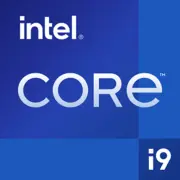Intel Core i9-9900T

Intel Core i9-9900T: Review and Relevance in 2025
Who is this processor for years after its release?
Key Specifications: Coffee Lake Architecture in the Era of 3 nm
The Intel Core i9-9900T, released in 2019, is still found in builds thanks to its unique combination of features.
- Architecture and Manufacturing Process:
Codename — Coffee Lake, 14 nm manufacturing process. Despite the dominance of 5–3 nm chips (such as Intel Meteor Lake or AMD Zen 5) by 2025, 14 nm here is a compromise between cost and energy efficiency.
- 8 Cores/16 Threads: Even in 2025, this is relevant for multi-threaded tasks.
- Base Frequency 2.1 GHz, Max Turbo Boost — 4.4 GHz: The low base frequency is offset by the "turbo mode" for short bursts of load.
- TDP 35 W: The main selling point of the processor. Allows it to be used in compact PCs and systems with passive cooling.
- Performance:
- Geekbench 6: Single-Core — 1429, Multi-Core — 6074. For comparison, the Ryzen 7 5700G (2021) scores around ~1500/8000. In single-threaded tasks, the i9-9900T is comparable to modern budget CPUs, but its multi-threaded performance lags behind newcomers.
- Integrated Graphics UHD 630: Suitable for office tasks and 4K video, but gaming is only feasible at low settings (e.g., CS2 — 30–40 FPS at 720p).
Compatible Motherboards: What to Choose in 2025?
The processor uses the LGA 1151-v2 socket, which supports 300 series chipsets:
- Z390: The optimal choice for overclocking (although the 9900T has a locked multiplier). For example: ASUS ROG Strix Z390-I (~$120–150 on the second-hand market).
- H370/B365: For budget builds. No overclocking support, but includes USB 3.1 Gen2.
- Important: Motherboards for Coffee Lake Refresh require a BIOS update. Many new boards in 2025 no longer support this socket, so look for options on auctions or in the refurbished segment.
Memory: Is DDR4 Still Relevant?
The i9-9900T supports DDR4-2666 MHz (in dual-channel mode). In 2025, DDR5 is dominant, but DDR4 remains advantageous for budget projects:
- Recommendations:
- 16 GB (2x8 GB) — minimum for multitasking.
- 32 GB (2x16 GB) — for rendering or virtualization.
- Example: Kingston Fury DDR4-2666 32 GB — around $80.
Limitation: No support for DDR5, which reduces upgrade potential.
Power Supply: How Many Watts Are Needed?
With a TDP of 35 W, the processor is extremely undemanding on the power supply:
- Without a discrete graphics card: A 300–400 W unit is sufficient (e.g., be quiet! Pure Power 11 400W — $60).
- With a graphics card: For RTX 4060 (TDP 115 W), 500–600 W is enough. Choose models with 80+ Gold certification (Corsair RM550x — $90).
Tip: In compact cases (e.g., Fractal Design Node 202), use SFX power supplies.
Pros and Cons of the i9-9900T in 2025
Pros:
- Energy efficiency: Ideal for HTPCs, mini-PCs, and office systems.
- 8 cores/16 threads: Good for video editing or working in Docker.
- Low price: On the second-hand market — $150–200 (compared to $250 for a new Ryzen 5 7600).
Cons:
- Outdated manufacturing process: Higher thermal output under load.
- No PCIe 4.0/5.0: NVMe SSD speed is limited to 3.0 (up to 3500 MB/s).
- Weak iGPU: A discrete graphics card is needed for gaming.
Use Cases: Where It Still Excels
1. Office and Multimedia:
- Document work, a browser with 20+ tabs, 4K video.
- Example: Connect to a 4K monitor via HDMI 2.0.
2. Home Server/NAS:
- Virtualization (Proxmox, ESXi) thanks to 16 threads.
3. Light Gaming:
- Paired with a GTX 1660 Super GPU — gaming at 1080p (Cyberpunk 2077 — 45–50 FPS on medium settings).
4. Upgrading Older Systems:
- Replacing an i5-8400 in an existing build on LGA 1151-v2.
Comparison with Competitors
- AMD Ryzen 7 5700G (8/16, TDP 65 W):
- Pros: More powerful iGPU (Vega 8), PCIe 4.0 support.
- Cons: Higher price ($200–250), requires AM4 motherboard.
- Intel Core i5-12400T (6/12, TDP 35 W):
- Pros: Alder Lake architecture (10 nm), higher IPC.
- Cons: Fewer cores, more expensive ($180–220).
Conclusion: The i9-9900T excels in multi-threaded tasks but falls short in energy efficiency and graphics.
Assembly Tips
1. Cooling: Even with a TDP of 35 W, under load, the processor can heat up to 75°C. Choose low-profile coolers (Noctua NH-L9i) or AIO coolers with a 120 mm radiator.
2. Motherboard: Check CPU support for the 9th generation on the manufacturer’s website.
3. Storage: Use NVMe SSDs (e.g., Samsung 970 EVO Plus) to unlock the speed of PCIe 3.0.
4. Case: For compact builds — Silverstone ML09 or Cooler Master N200.
Final Conclusion: Who Is the i9-9900T Suitable For?
This processor is worth considering in three scenarios:
1. Upgrading an old system on LGA 1151-v2 without replacing the motherboard.
2. Building an energy-efficient PC for office use, a media center, or as a server.
3. A budget workstation for rendering or programming.
Target Audience:
- Enthusiasts who appreciate the balance between price and multi-threaded performance.
- Users who do not need PCIe 4.0 or DDR5.
In 2025, the i9-9900T is a "dark horse" for niche scenarios, but not for gamers or those pursuing the latest technologies.
Basic
CPU Specifications
Memory Specifications
GPU Specifications
Miscellaneous
Benchmarks
Compared to Other CPU
Share in social media
Or Link To Us
<a href="https://cputronic.com/cpu/intel-core-i9-9900t" target="_blank">Intel Core i9-9900T</a>